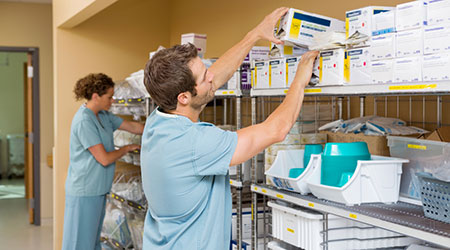Q: If patient room equipment such as hospital beds, night stands, overbed tables, etc., is stored in an unoccupied patient room, is that space then considered to be a storage room? If so, then door closers would be required to make the room compliant as long as it is a fully sprinklered building? Also, is there a difference in storing essentially metal equipment such as beds and night stands, as opposed to combustibles such a paper files and boxes in unoccupied patient rooms?
A: Yes… There is a difference in storing equipment that is all metallic and supplies & equipment that are combustible. Section 19.3.2.1.5 (7) of the 2012 LSC says rooms or spaces that are larger than 50 square feet used for the storage of combustible supplies and equipment in quantities deemed hazardous by the AHJ are considered to be a hazardous area. The issue is how many combustible supplies and equipment constitute a hazardous area? That is decided by the AHJ, or more to the point, the surveyor working for the AHJ. The bottom line is, it doesn’t take too much combustibles for a surveyor to decide what is a hazardous area. A bed mattress and linens is considered combustible. Furniture made with wood is considered combustible. Nearly all supplies used in a healthcare facility are packaged in either paper, plastic or cardboard; all combustible.
So, if you store extra beds in an unoccupied patient room, and the beds are equipped with linen and mattresses, then that would likely be decided by the surveyor to be a storage room containing combustibles. If the room does not meet the requirements of 18/19.3.2.1 for hazardous rooms, then you would likely be cited. For temporary situations, like staging combustible construction materials in an unoccupied patient room for a project, an ILSM assessment identifying the room is temporarily storing combustibles and does not comply with 19.3.2.1.5 for hazardous areas, should be acceptable since the healthcare facility identifies their deficiency and recognizes it is a short-term situation. Compensating measures in the ILSM assessment could be daily inspections and notification of staff of the deficient storage room.
Brad Keyes, CHSP, is the owner of KEYES Life Safety Compliance, and his expertise is in the management of the Life Safety Program, including the Environment of Care and Emergency Management programs.

 Hand, Foot and Mouth Disease on the Rise
Hand, Foot and Mouth Disease on the Rise Preparing for the Hazards of Winter Weather
Preparing for the Hazards of Winter Weather BayCare Reveals Pagidipati Children's Hospital at St. Joseph's
BayCare Reveals Pagidipati Children's Hospital at St. Joseph's Why Identity Governance Is Becoming a Facilities Management Issue
Why Identity Governance Is Becoming a Facilities Management Issue Habitat Health Opens South Los Angeles PACE Center
Habitat Health Opens South Los Angeles PACE Center